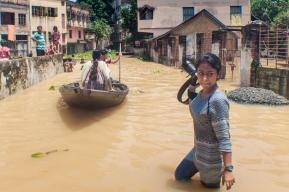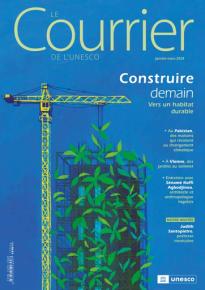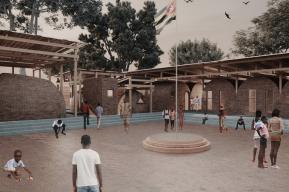فكرة
في تاهيتي، التقاليد تسارع إلى إنقاذ البحيرة

في جنوب الجزيرة، أُعيد العمل بتقليد "الـّراهْوِي"، وهو إجراء يمنع الصيد خلال فترةٍ محدّدة، بهدف السّماح للحياة البحرية بالتجدّد.
إستير كونيو
صحافية في بابيت
بعيداً عن ضجيج العاصمة بابيت، تبدو الغابة الكثيفة في تلك المنطقة التي لا تجتازها أيّة طريق سالكة، أكثر سكوناً وأمانا تحت المطر. هذه "الأرض المحبوبة من الآلهة" أو "فينوا هيري هيا تي آتوا" كما يسمّيها القدامى في اللّغة التاهيتية، تشير إلى شبه جزيرة تايارابو الواقعة في الجنوب الشرقي من جزيرة تاهيتي. وهي معروفة أكثر باسم "فينوا أيْهيري" أي "أرض الأحراش"، وتمثّل آخِر منطقة غابيّة بريّة في الجزيرة الرئيسية لجزُر بولينيزيا الفرنسيّة. ويتقاسم هذه الأراضي الخضراء إقليمان إداريّان هما تيهوبو على الساحل الغربي وتُوتيرا شرقاً.
ولا تزال الغابات العذراء المنتشرة في المنطقة تضمّ العديد من "الماريات" marae أي الفضاءات المقدّسة التي كانت تُقام فيها طقوس العبادة البولينيزيّة القديمة. وهذا ما يجعل السكّان الستّمائة لـفينوا أهيري يعتقدون أنّ أرضهم مفعمة بالـ "مانا"، تلك الطاقة المنبعثة من الطبيعة.
تؤكّد آنيك باوفيه، المناضلة ورئيسة جمعية "الدفاع عن فينوا أهيري" أنّ: "المانا موجودة لأنّ هذه المنطقة مَحميّة. إنها مكانٌ سِحريّ. واحتراماً لأولئك الموجودين في عالم الماوراء ينبغي ألا تُشيّد فيها الطّرُقات". وبالفعل، فإنّ القلّة من سكّان المدينة الذين حاولوا الدفاع أمام المَحاكم عن شقّ طريق سالكة توصلهم إلى مساكنهم الثانويّة قد خسروا دعاويهم. وتؤكّد آنيك باوفيه: "من أراد أن يسكن في فينوا أهيري، لا خيار له سوى المجيء سيرا على الأقدام أو في زورق أو سفينة".
ولكنْ هنا، كما في أماكن أخرى من العالم، بدأت حالة البحيرة في التدهور منذ تسعينيّات القرن الماضي. وظهر اختلال التنوّع البيئيّ من خلال تراجع الثورة السّمكية، وتزايدِ الأصناف المجتاحة كنجم البحر الشوكي الملتهم للمرجان (أكانثاستر)، وتضاؤلِ عدد من الأنواع الخاصّة بالمنطقة كالسمك الجرّاح والنابليون.
هذا، وقد نشبت نزاعات بين صيّادين جاؤوا من خارج المنطقة، جذبتهم غزارة الموارد السمكية، وصيّادي تياهوبو. إزاء هذا الوضع، تعالت منذ نهاية التسعينات أصوات تطالب بتنظيمِ استغلال أفضل لمياه البحيرة. وتروي آنيك باوفيه أنّ "صيّادين محليّين شعروا بالخوف وطلبوا منّي تأسيس جمعيّة لإعادة العمل بتقليد الرّاهْوِي".
تحالف السياسيّ والمقدّس
منذ عقود من الزّمن، وقع التخلّي عن ممارسة " الرّاهْوِي"، وهو من الطّقوس التقليدية التي تحرّم النّفاذ إلى مجال بحريّ معيّن أو تحدّ منه وتمنع الحصول على مورد من موارده أو بعض منه خلال فترة محدّدة. وهذا التحريم، الذي تُقرّره عشيرة ما أو زعامة تقليدية، كان في الأصل مرتبطاً بالشأنَ السّياسيّ وبالمقدّس في الآنٍ ذاته. وكان التابو tapu، وهو الحظْر المؤقّت، يلقى تكريسه في طقس تعزيميّ مقدَّس يقوم به آرييي ari'i (ملك) أو تاهوا tahu'a، وهو وسيط يؤمّن الصلة بين عالم الأرواح ودنيا الأحياء. يقول جيرار باركر، العمدة السابق لـتياهوبو، أنّه "في القرن الثامن عشر، عندما أقام المحارب فيهياتوا نظامَ الرّاهْوي في تياهوبو، كان كلّ من يخرقه يُعاَقب بالموت".
ويوضّح إيف دودوت، العضو المؤسِّس في جمعيّة هورورو، والمُدافِع المتحمّس عن التراث الثقافيّ أنّ "تدخّل عالَم الأرواح هذا يدوم طالما احتاجت إليه الطبيعة والحيوانات والأشجار والأسماك لتتجدّد". ويعود سِرّ نجاعته إلى "المانا"، التي تتنزّل في قلب الثقافة البولينيزيّة. وقد كتب برنار ريغو، المسؤول السابق عن مختبر الأبحاث في مجال العلوم الإنسانية بـبولينيزيا الفرنسية أنّ البولينيزيّين، "كانوا قبل الاحتكاك بالغرب، لا يعيشون في الطبيعة، بل في ارتباطٍ بقوى محمّلة قداسة".
وبقدر ما كان الصيّادون متحفّظين إزاء المجالات البحرية المحمية التي ضبطتها السّلط، أبدوا قبولا إيجابيا بإعادة العمل بـالرّاهْوي. وقد أكّد إيف دودوت أنّ "الـرّاهْوي يستمدّ نجاعته من كونه يتميّز عن الحظر الإداريّ بقوّته الرّدعية ذات الطبيعة المقدّسة". ويرى برنار ريغو أنّ "السلطات البشرية الصرفة والاعتباطية لا تتمتّع سوى بقوّة إقناع ضعيفة". ويضيف أنّ العقوبة في علاقة بالـّراهوي "يتعذّر الإفلات منها، لأنّ خرْقه يمثّل قطيعة في الدّورة المقدّسة، ومخالفة من هذا القبيل من شأنها أن توجّه كلّ الطّاقة ضدّ المخالف".
عودة الأسماك
في البولينيزيا الفرنسية، كان سكّان رابا (أرخبيل الأُسترال) وسكّان ماياوو (أرخبيل جزُر الجمعية) أوّل من أعادوا العمل بالـرّاهْوي في جزء من جزُرهم في بداية الألفية الثانية.
وقد وجب انتظار سنة 2014 لإقامة راهوي على مساحة 750 هكتاراً من بحيرة تيارابو الشرقيّة تُشرف عليه لجنة تسيير مؤلّفة من منتخَبِين، وممثّلين عن الصيّادين، وجمعيات محليّة، وعلماء، وممثّلين عن إدارة البيئة. تقول آنيك باوفيه: "الـرّاهوي عندنا عادةٌ لم تعد موجودة منذ عهد بعيد. وقد استغرقت العودة إلى ممارسته زمناً طويلاً". واليوم، أصبح الـرّاهوي يتمتّع، بفضل تعاون سكّان فينوا أهيري منذ 2016، بحماية قضائية بمقتضى قانون البيئة حيث تنصّ المادّة LP 2122-1 على أنّ "الـرّاهوي مجال بريّ و/أو بحريّ تسري عليه قواعد غير مكتوبة، تُمليها ضرورات إدارة الموارد الطبيعية، وتطبّق بطريقة تقليدية".
يغطّي الـرّاهوي اليوم 5% من البحيرة. وبعد ستّ سنوات من استعادة العمل به تبدو المعاينة واضحة من خلال عودة الأسماك. ولكن لا يعني هذا رفع الحظْر بل إنّ لجنة إدارة البحيرة تفكّر في إدامته خشية تدهور الأنواع البحرية من جديد.
وتحذّر رئيسة الجمعية قائلةً: "الأسماك عادت من جديد لكن لو رفعنا الحظر فلن يمضي وقت طويل حتى تنفد الثروة السمكيّة". ذلك أنّ مياه البحيرة الغنيّة بالأسماك تجذب الأطماع دوماً. ولئن يوجد عون واحد فقط، مكلّف رسميّاً بحراسة الموقع، فإنّ أبناء المنطقة ساهرون بدورهم على حمايتها. وتضيف آنيك باوفيه: "في اللّيل، يحدث أن نلمح مصابيح يدويّة تجول، وقتها نتدخّل حالاّ".
معركة السّاحل
يودّ بعض سكّان فينوا أهيري اليوم توسيع الحماية التي تغطّي المنطقة البحرية لتشمل السّواحل البريّة. وتقرّ آنيك باوفيه بأنّه "لا يمكن حماية المجالات البحرية من دون إدراج الساحل، لكنّ إقناع السكان لن يكون سهلا". وفعلا، فإنّ هذه المنطقة التي تأوي مسار التجوّل الشهير "تي باري"، بأجرافه الصخريّة البازلتية الغائصة في المحيط، تمثّل مقصدا هامّا للمتجولين على الأقدام. ولئن بقيت هذه البقعة الفردوسية الصغيرة محميّة من كلّ نشاط إنسانيّ، فإنّ البحيرة المتاخمة لمدينة بابيت ما فتئت تمتلئ على نحو منتظم بالترسّبات في موسم الأمطار بفعل الأخاديد الناجمة عن الزّحف العمراني على سفح الجبل.
لقد استطاع الـرّاهْوي المتأصّل في التقاليد أن يفرض نفسه، مع مرّ السّنين، كطريقة في الإدارة المستدامة للموارد البحريّة. وتشير دراسة نشرتها وكالة الاستشارات ألفيا كونسولتنغ في 2019 إلى أنّ الـرّاهوي يحظى اليوم بتأييد 90% من سكان بولينيزيا الفرنسية. وقد عقّب إيف دودوت على ذلك بقوله: "إنّه أمر يبعث على الاطمئنان إذ يثبت أنّنا قادرون اليوم على أن نعيش مثل أسلافنا بفضل هذا النظام"، ويطالب بإقامة منطقة للـرّاهوي في وادي بابينو شمال الجزيرة، قائلا: "ينبغي أن نعود إلى المقدّس، وإلى المصلحة العامّة. لا خيار آخر لدينا. فعندما يعيش المرء على متن زورق عليه أن يكون هو والعالَم واحداً".
مطالعات ذات صلة
"عندما تشرب من الماء فكّر، في النبع"، رسالة اليونسكو، يناير-مارس 2019
اشترك في رسالة اليونسكو لمتابعة الأحداث. الاشتراك في النسخة الرقمية مجاني 100%.
Esther Cunéo
Journalist based in Papeete
Far from the bustle of Papeete, the jungle of Tahiti Iti, or the Taiarapu Peninsula, appears even more luxuriant in the rain. Located on the island’s south, this “Land beloved of the gods” – or Fenua here hia te atua, as the elders still refer to it in Tahitian – is undisturbed by roads.
Better known as Fenua Aihere (land in the bush), it is the last remaining wilderness on the main island of French Polynesia. Two villages share these verdant lands – Teahupoo on the south-western coast and Tautira on the south-east.
The virgin forests that cover the area still conceal several marae, the sacred ceremonial and social spaces where ancient Polynesian rites were once performed. This is why the 600 inhabitants of Fenua Aihere say their land is infused with mana, the supernatural power that emanates from nature.
“The mana exists because this area has been preserved, it’s really a magical place. Out of respect for those in the beyond, we should not build a road here,” insists Annick Paofai, president of the association to protect Fenua Aihere. In fact, the few city dwellers who have tried to defend the construction of a path to their second homes have been turned down by the court. “If you want to live in Fenua Aihere, the only way to get there is on foot, by pirogue [a canoe] or by boat,” Paofai insists.
But here, as elsewhere, the health of the lagoon began to decline in the 1990s. The loss of biodiversity was reflected in a reduction in fish stocks; the proliferation of invasive species like the Acanthaster planci, a coral-eating starfish; and the depletion of certain key species like the surgeonfish.
Attracted by a resource that was reputed for its abundance, fishermen from outside the area started fishing here, leading to clashes with the Teahupoo locals. These conflicts have led to calls for better regulation of the use of the lagoon, since the end of the 1990s. “Local fishermen were afraid [to lose their livelihoods], and asked me to set up an association to revive rahui,” Paofai explains.
Mixing politics and the spirit world
A traditional practice that has not been used for decades, rahui consists of temporarily restricting or banning access to the harvesting of essential resources in the forest, land or sea to allow the area to naturally regenerate itself. Imposed by a clan or chieftaincy, this prohibition was originally both a political and a sacred matter. The tapu, or temporary taboo, was invoked through a sacred chant by an ari'i (king) or a tahu'a, a medium acting as a link between the spirit world and the living. “In the eighteenth century, when the warrior Vehiatua introduced rahui to Teahupoo, anyone who did not respect it was condemned to death,” says Gérard Parker, a former mayor of Teahupoo.
“This intervention by the spirit world lasts as long as it takes for nature, the animal, the tree, or the fish, to regenerate itself,” explains Yves Doudoute, founding member of the Haururu association, and a strong advocate for the region’s cultural heritage. The key to its effectiveness is mana, which is at the heart of their culture. “Before they came into contact with the West, Polynesians did not live in nature, but in relation to entities charged with sacredness,” writes Bernard Rigo, cultural anthropologist and former head of the Human Sciences Research Laboratory of French Polynesia.
While fishermen were opposed to the setting up of a marine protected area by the authorities, they were more open to the introduction of rahui. “The sacred nature of rahui sets it apart from an administrative ban, making its dissuasive powers more effective,” Doudoute states. “A purely human and random form of authority has limited power of persuasion,” confirms Rigo. In contrast, with rahui, it is believed that the punishment is “inevitable, because its transgression breaks the sacred circuit, and all the energy is diverted against the transgressor.”
The fish return
In French Polynesia, the inhabitants of Rapa in the Austral Islands, and Maiao in the Society Islands, were the first to reinstate rahui in the early 2000s on parts of their islands.
It was not until 2014 that a rahui was created in the lagoon of Taiarapu-Est. Covering a marine surface area of 750 hectares, the lagoon is managed by a committee made up of elected officials, fishermen’s representatives, delegates from local associations, scientists, and officials from the environment department. “This custom has not existed here for a long time. That is why it has taken a while to return to this practice,” explains Paofai.
Thanks to the efforts of the inhabitants, the rahui has been legally protected under French Polynesia’s environmental code since 2016. Article LP 2122-1 stipulates that: “The rahui is a land and/or marine area over which unwritten rules dictated by a resource management imperative are applied in a traditional manner.”
Today, the rahui covers five per cent of the lagoon. Six years later, the result is clear: the fish have returned. But for now, there is no question of lifting the ban. Fearing a new decline in marine species, the management committee is even thinking of making it permanent.
“The fish have come back, but if we lift the rahui, it won’t be long before the stocks are depleted again,” warns Paofai. The threat of outsiders coveting the lagoon’s abundance has not waned. Although only one guard has been assigned to watch over the site, the local residents remain vigilant. “At night we sometimes see mori pata (flashlights). In that case, we intervene,” the president of the association says.
The battle to save the coast
Some inhabitants of Fenua Aihere would like to extend the marine protection that applies to the maritime zone to the coast – to establish continuity between the land and the sea. “You cannot protect the marine areas without including the coastline, but convincing the local residents will not be easy,” admits Paofai. The area that hosts the Te Pari hiking trail, with its spectacular views of basalt cliffs plunging into the ocean, is very popular with tourists – it would be hard to keep visitors away. And while this little corner of paradise is still largely protected from human activity, the lagoon waters surrounding Papeete, the capital, are regularly clogged during the rainy season because of the furrows dug to accommodate the increased urbanization of the mountainside.
Anchored in tradition, rahui has, over the years, become established as a sustainable means of managing marine resources. According to a 2019 study by Alvea Consulting, a management consulting firm based in Papeete, rahui is supported by ninety per cent of the inhabitants of French Polynesia today. “That’s reassuring. It proves that it is still possible to live like our ancestors, thanks to this system,” Doudoute says. He is calling for a rahui zone in the Papenoo valley, in the north of Tahiti, which is known for its spectacular waterfalls. “We must return to the sacred, to the common good. We have no choice. When you live on a pirogue, you must become one with the world.”
Today, rahui is supported by ninety per cent of the inhabitants of French Polynesia

In the same issue








